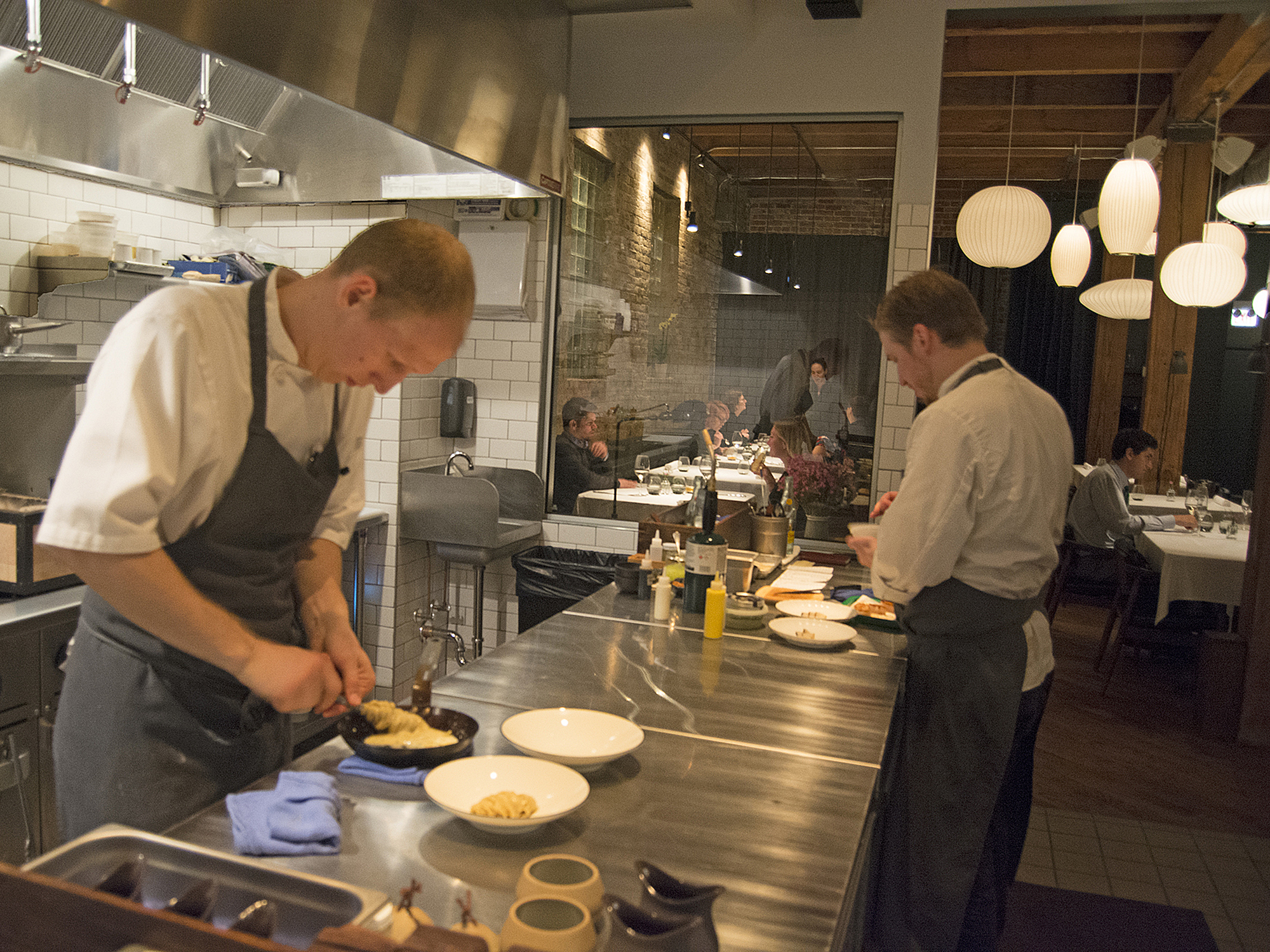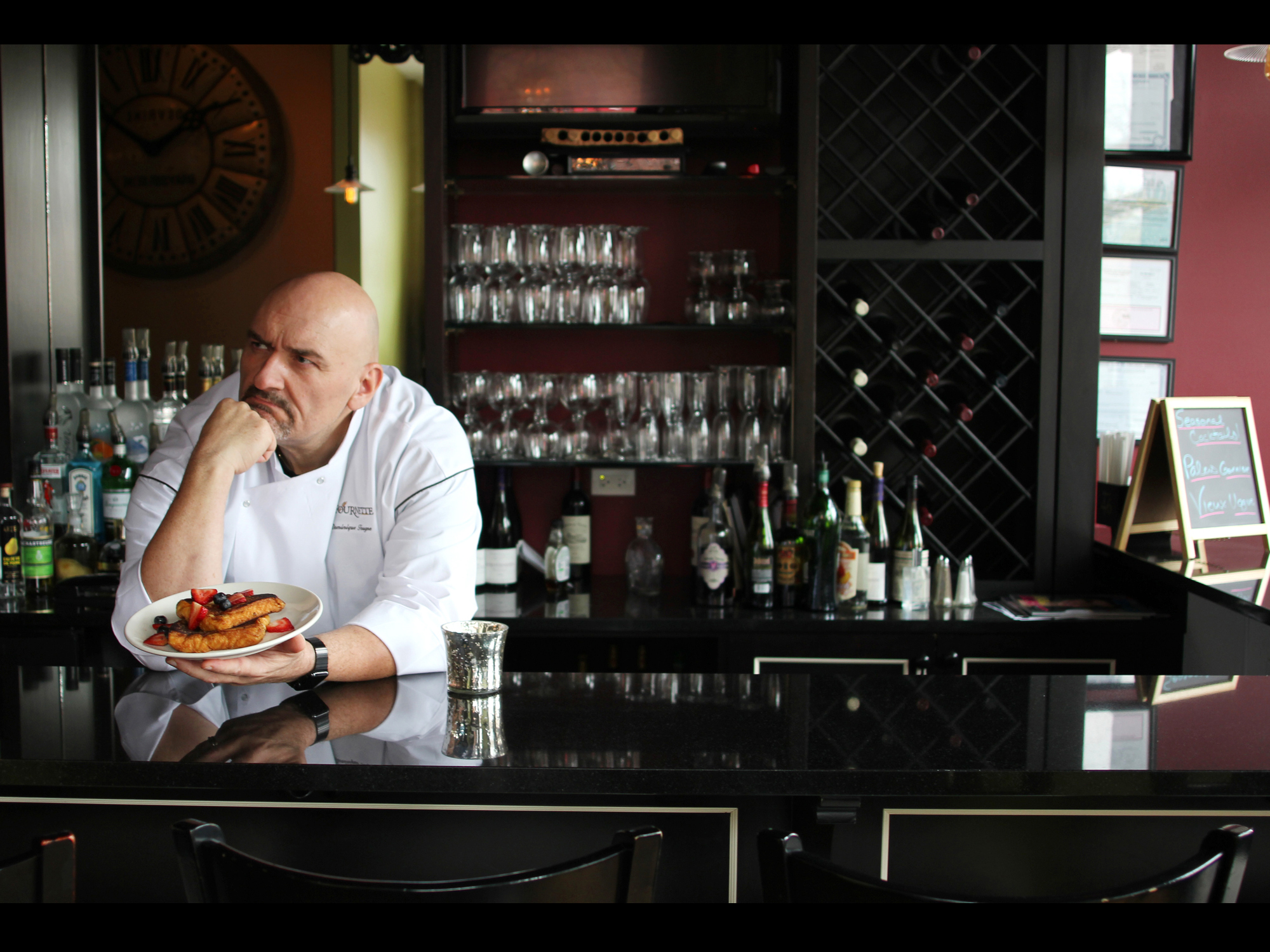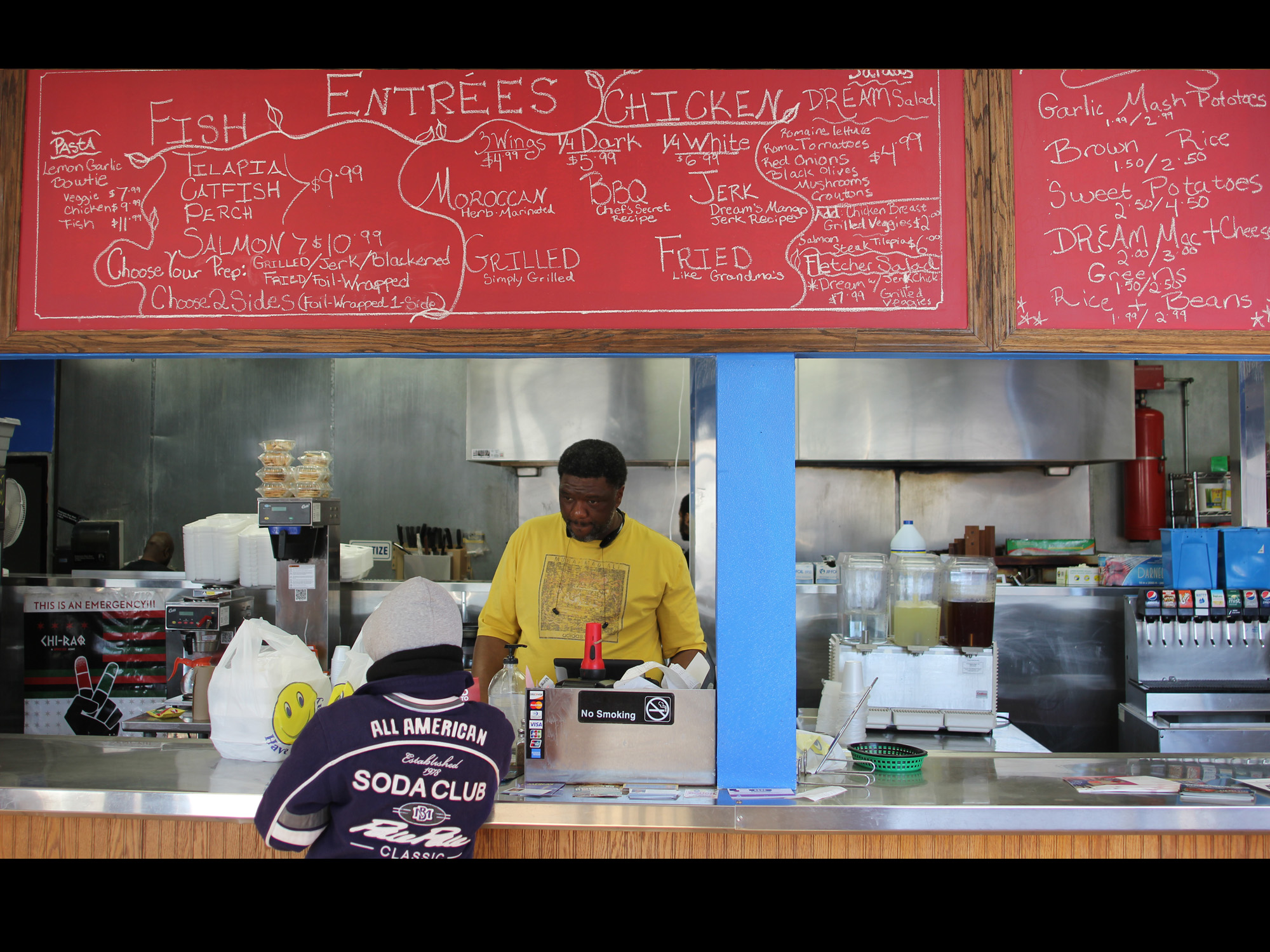FOR WHITE NORTH SIDERS, MAC ‘N’ CHEESE is the quintessential comfort food, a primary-colored dish of simple cheesy-buttery flavors that is unavoidably associated with childhood prepared out of a Kraft box. Take that nostalgia, add some more adult flavors—blue cheese, truffle oil, sriracha, whatever—and you’ve got a perfect bro bar dish for a palate that’s been softened up by beer and in need of carbs full of good feelings. People who’ve already had a few are the perfect audience for a foodstuff whose name barely even has any entire words in it. Mac ‘n’ cheese. Maggajeez. Comfort. Foooooood.
But mere hedonistic comfort isn’t what mac ‘n’ cheese means to African-Americans. For black Chicago, mac ‘n’ cheese isn’t comfort food—it’s soul food, and that’s a whole different thing.
Mac ‘n’ cheese is an essential part of the soul food canon, earning a full chapter in Adrian Miller’s James Beard Award-winning book Soul Food: The Surprising Story of an American Cuisine, One Plate at a Time, same as fried chicken, collard greens and red Kool-aid. When I interviewed Miller for the Reader in 2014, I asked him about his point that mac ‘n’ cheese was an example of a European dish in origin—nobody was making a noodle gratin in 18th century Ghana—that went from fancy food at the slaveowners’ dinner tables to one that African-American cooks took home with them:
It’s a rare example of a double influence because African-American cooks were cooking in the big houses on these plantations, were making this dish for their masters, but then you’re getting it at the low end. And what’s interesting about mac ‘n’ cheese is that it was really popular before we had huge waves of Italian immigrants in this country. Because usually what happens is that an ethnic food becomes popular after the people show up.
I know older African-Americans who believe that African-Americans invented mac ‘n’ cheese, and that white people are stealing it from us. When it’s clearly the opposite. I don’t know if Thomas Jefferson was the first, because it’s in some of the early cookbooks, but he was a big mac ‘n’ cheese fan. I mean, any man that smuggles a macaroni maker out of Italy, you know he’s got a mac ‘n’ cheese jones.
LAST WEEK THE TRIBUNE ENDED a month devoted to mac ‘n’ cheese, a hardcore application of resources that included a mac-‘n’-cheese-of-the-day restaurant slideshow, a history of how it became an American classic, recipes, hacks for turning extra powdered cheese packets into homemade Doritos seasoning, a boxed mac ‘n’ cheese taste test and more.
At first there was no reason to suspect that mac ‘n’ cheese’s centrality to soul food would be neglected—on day two of the slideshow, Bill Daley featured the mac at MacArthur’s, the most celebrated west side soul food cafeteria. Daley also wrote this history of the dish, which quoted Miller in the process of acknowledging the African-American involvement in the dish—in the 19th century.
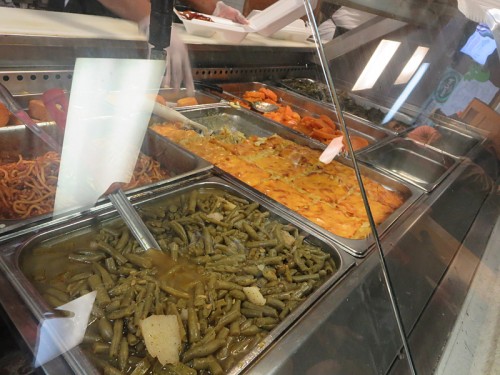
MacArthur’s, 5412 W. Madison
But it would be nearly a month of bro bars, interspersed with the occasional River North or Streeterville steak house, before the first appearance of a south side African-American restaurant—Miss Lee’s Good Food on Garfield Boulevard, which Louisa Chu wrote about on March 30. You’d hardly know from that that mac ‘n’ cheese is a signature African-American dish.
And there’s no doubt that that’s what it is. I met Chef Ron Taylor, co-owner of Windy City Chefs, which offers catering and private chef services, at the dinner for Jonathan Gold at the Currency Exchange Cafe in Hyde Park a couple of weeks ago, and asked him about mac ‘n’ cheese. He took the conversation straight to cooking with Grandma.
“Mac ‘n’ cheese was always one of those staples. My grandmother would fix it, definitely on Sunday, and sometimes she might serve it during the week,” he said. “It was just one of those things, a cost-effective filling meal. You could feed a lot of people with it.”
I keep it straightforward, thinking of my grandmother. It makes me have good thoughts of cooking with her.
I asked him if she made it from scratch or from the box. He exploded in mock horror: “Never from the box, my friend, never from the box! She made mostly everything from scratch. Maybe she used a few shortcuts when she got older. But when I make it, I always make it from scratch. Start by making a nice bechamel sauce, shredding some sharp cheddar,” he emphasized, so there’s no idea in anybody’s head of using the V-word, Velveeta. “I keep it straightforward, thinking of my grandmother. It makes me have good thoughts of cooking with her.”

Pearl’s Place (not the north side Pearl’s which appears in the Tribune slideshow), 3901 S. Michigan
Taylor learned the appeal of cooking for people from these times with her in the kitchen, and I ask him if he’s passing that on to anybody. “My daughter’s three, so it’s a little early for her. But my niece grew up with me, she’s going to be 21, and she learned to cook from watching me. It makes you proud that you’re carrying on tradition.”
Which is honorable, but it might be one reason for not devoting a lot of coverage to the south side versions of the dish—there’s not so much to say if they’re all traditional, by-the-recipe-book. I asked Taylor what would happen if he showed up at a birthday or some other event with the kind of fusion mac ‘n’ cheese you see in restaurants on the north side—lobster mac ‘n’ cheese, say. Would people he knows be glad to see it, or regard it as fixing something that’s never been broken?
“If it’s me, they’re all going to say, ‘I’m gonna eat Ron’s mac and cheese,’ because they know I’m a chef and I’m going to add a little culinary pizzazz to it,” he replied. But generally, “If you look at each ethnic group’s food, it’s really straightforward. Mexicans make straightforward Mexican food. Italians make straightforward Italian food. African-Americans keep mac ‘n’ cheese pretty straightforward, baked in the oven, nice and creamy—and that’s how it is.”
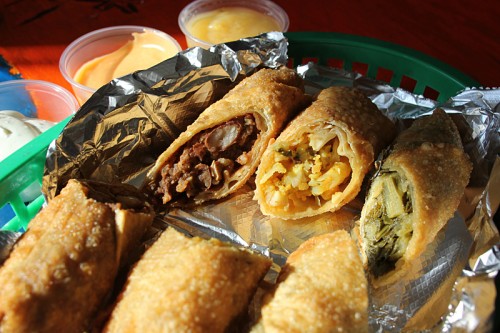
Jerk chicken, mac and cheese and greens egg rolls with dipping sauces, Dream Cafe and Grille, 748 W. 61st
SO MAYBE SOUTH SIDE MAC ‘N’ CHEESE isn’t that interesting culinarily—though that may oversell how culinarily interesting comfort mac ‘n’ cheese with a pound of butter in it at a River North joint is, too (and there were four of those in the Tribune’s slideshow). But even if it were true, there are still interesting stories to be had, somewhere, maybe less about how the mac ‘n’ cheese is made than what it means to people, this thing that turns up at every wedding and (all too often in Chicago) at every funeral?
I found a mac ‘n’ cheese story that seemed interesting enough to me in Englewood just a few weeks ago, at Dream Cafe and Grille. Looking at a generation of kids who only ever ate fried food in that food desert, owner Howard Bailey and his chef used egg roll wrappers as a way of introducing the kids to three soul food classics—jerk chicken, collard greens, and, you guessed it, mac ‘n’ cheese.
“When we were getting ready to open, we wanted something that was a gateway food. Because we knew people were used to having fried objects, so we thought, what if we took something healthy and deep-fried it?” said Bailey. “A lot of people are like, everything was good but the egg rolls… we literally get people coming in for the egg rolls.”
I don’t think I discovered the only south side mac ‘n’ cheese story there is that day (though, really, everything was good, but the egg rolls…). I feel confident there are plenty of stories out there, all over the city, and a good case to be made that the south side has more than most, deeper stories that have more to say about people and family and hard times and memories.
It may be bright yellow, but there’s blues in the south side’s mac ‘n’ cheese. Soul food is born out of the kind of experiences that cry out to be made into great stories. And they’re out there, if you’re willing to look all over town for them, beyond the hot restaurant neighborhoods where the mac ‘n’ cheese flows easy as wine. Like the old slogan of journalism’s social mission says, the job of the press is to comfort the afflicted—and afflict the comfort food.
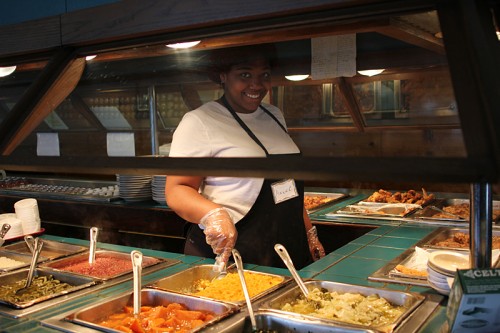
St. Rest No. 2 Country Kitchen, 727 E. 87th
Michael Gebert is Agent Double-O Soul of Fooditor.
COVER IMAGE: Morrison’s, 8139 S. Ashland
Latest
Join the Discussion
After you comment, click Post. If you're not already logged in you will be asked to log in or register with Disqus.




